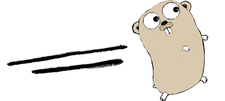Go version 1 series
Well Executed

© Lead Image CC BY-SA 3.0
The Go programming language helps programmers avoid the annoying routine and focus on the important stuff.
In 2009, Google launched the Go programming language [1]. An impressive collection of veteran developers worked on Go, including Ken Thompson (one of the inventors of Unix), Plan 9 co-creator Rob Pike, and Rob Griesemer, who previous worked on Google projects such as the Smalltalk variant Strongtalk.
The goal of Go was to create a statically typed language similar to C, but with updated features such as garbage collection and better type safety. In addition to its trademark CSP (Communicating Sequential Processes) [2] concurrency solution, the influences of Limbo [3] and Inferno [4] are evident.
Early versions of Go evolved at a rapid pace, with the code changing so fast that applications written one week would no longer compile in later versions. Finally, in 2012, Go 1.0 was released with the promise that you would be able to compile any code in future versions of the 1.x series. Since then, the focus of the Go developers has been on tools, compilers, and the run time.
[...]
Buy this article as PDF
(incl. VAT)
Buy Linux Magazine
Subscribe to our Linux Newsletters
Find Linux and Open Source Jobs
Subscribe to our ADMIN Newsletters
Support Our Work
Linux Magazine content is made possible with support from readers like you. Please consider contributing when you’ve found an article to be beneficial.

News
-
Two New Distros Adopt Enlightenment
MX Moksha and AV Linux 25 join ranks with Bodhi Linux and embrace the Enlightenment desktop.
-
Solus Linux 4.8 Removes Python 2
Solus Linux 4.8 has been released with the latest Linux kernel, updated desktops, and a key removal.
-
Zorin OS 18 Hits over a Million Downloads
If you doubt Linux isn't gaining popularity, you only have to look at Zorin OS's download numbers.
-
TUXEDO Computers Scraps Snapdragon X1E-Based Laptop
Due to issues with a Snapdragon CPU, TUXEDO Computers has cancelled its plans to release a laptop based on this elite hardware.
-
Debian Unleashes Debian Libre Live
Debian Libre Live keeps your machine free of proprietary software.
-
Valve Announces Pending Release of Steam Machine
Shout it to the heavens: Steam Machine, powered by Linux, is set to arrive in 2026.
-
Happy Birthday, ADMIN Magazine!
ADMIN is celebrating its 15th anniversary with issue #90.
-
Another Linux Malware Discovered
Russian hackers use Hyper-V to hide malware within Linux virtual machines.
-
TUXEDO Computers Announces a New InfinityBook
TUXEDO Computers is at it again with a new InfinityBook that will meet your professional and gaming needs.
-
SUSE Dives into the Agentic AI Pool
SUSE becomes the first open source company to adopt agentic AI with SUSE Enterprise Linux 16.

